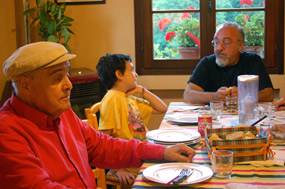
Once a city that had a university, this beautiful center of the Italian Renaissance has evolved into a university attached to a city. The last natives wonder what their future holds.
Antonio Bisciari looks over this famous Renaissance city that has been his family’s home for 150 years and sees what the tourists see: a picture-perfect postcard town of unforgettable beauty. But he also sees something else.
“The people I grew up with are no longer here,” Bisciari said. “So, staying in Urbino, a beautiful city, a marvelous city, but alone and with no friends is not worth it.”"
“If you stay here for too long, Urbino becomes a jail; it’s not as good as one would think,” he said.
To the thousands of tourists who flock to this scenic city each year, Urbino seems as lively and prosperous as it must have looked when the Duke of Urbino made it the hub of the art world in the 14th century. But beneath the facade of robust health lurks a different story.
According to city authorities, 4,000 of the 5,000 people living inside the walls of this ancient town are students. Although the exact figure isn’t known, some local experts, including University of Urbino professor Eduardo Fichera, estimate that the number of families living full time within the walls of Urbino is less than two dozen.
The Bisciaris are one of these last families. Felice Bisciari is Antonio’s father, and also the grandfather of Anna and Paolo. Though their family’s existence in Urbino dates back more than 150 years, the lingering question is, how much longer will their ancestral name will be carried within this little city?
The Stacciolis are another remaining family. Lamberto Staccioli, a lifelong resident who raised his family here, is Giorgio Staccioli’s father, and two-year-old Eduardo Stacciolia’s grandfather.
“It is necessary to always remember where your family roots lie,” Lamberto Staccioli said. He wants to give his family the feeling and sense of belonging with which he was also raised.
Today all the Stacciolis live within the same fortress walls, but Eduardo is being raised very differently than his father. The atmosphere of the town has created a dramatic cultural shift.
Giorgio Staccioli grew up with nine of his closest friends. He left town to attend college, came back and opened his own bar, and built a family here. But upon his return, eight of those ten families had moved on, leaving Giorgio and only one of his childhood friends to continue their lives together in their hometown. This trend had become prevalent, as Urbino transformed from a small city with a university to a university with a small city.
Younger Urbinate are conflicted over whether to stay within the historical walls they love, or to leave in search of bigger opportunities. They say that the choice is between different hurts: The feeling of missing your hometown, or the feeling of being alone in your hometown.
“You have to stay in Urbino on the 24th of December, the day before Christmas, when there are no students around, to notice how small Urbino is and how alone you really are,” Antontello said.
Carmen Staccioli, Girogio’s wife, is also struck with the same feeling each July.
“Once the students have left, this town becomes so empty. It becomes really sad and difficult to come to work,” she said.
Antonio Bisciari believes Urbino is a beautiful and magical city, but that “it’s a town from fables, and when you’re 20 years old it’s perfect, it’s the right town, there are no dangers around and nothing bad ever happens. But when you are a grown-up man and you want to have a family it gets difficult.”
Those difficulties revolve around finding work, and places to live. The job market mostly has two options: working for the university, or running a shop. And real estate is expensive because student rents drive prices up.
So Bisciari deals with a 90-minute daily commute to work. He feels the commute is worth it, because he wants to raise his family here, close to their roots. However, the saddening feeling of seclusion still tears at him.
“Living within the walls of the city is expensive, and Urbino doesn’t offer a lot of work,” Carmen Staccioli said. “The opportunities are very limited.”
Though she only moved here seven years ago, she claims she has seen the city evolve.
“The way of living is really different now,” Felice Staccioli said. “Fate allowed the exterior part to remain as it was, luckily, but the relationships between people have really changed. Now everyone just ‘harvests their own fields,’ and there is more individualism; in the past there was much more solidarity and brotherhood.”
In Lamberto and Felice’s youth, the streets resonated with the laughter of children, and piazzas were places where families and friends gathered. But now, the sounds of partying students drinking from open beer and wine bottles echo down the narrow cobblestone streets, from early afternoon until three in the morning, making it hard for children and year-round residents to sleep.
But while the last residents of Urbino see the students changing the quality of the life they cherish, they also know that their livelihoods and futures are tied to these same students.
“The youth help boost the town’s economy because they are constantly buying drinks, shopping, and keeping the town alive,” Lamberto said.
Antonio’s brother’s family has already moved away, five hours north to Bolzano, leaving Anna and Paolo as the only future Bisciari descendants in Urbino.
“I belong to a generation that just wants to move away and look for something out of these walls,” said 17-year-old Anna.
She and her brother wrestle with the tough decision over whether to raise their own families here, or to search for better opportunities. Though it would make their family happy if they stay and continue the family legacy, they want their children to choose for themselves.
“I can only help them to choose, but it’s their call,” Antonio said. “I’d like them to stay here and have children here; I’d be happy. But it’s their happiness, not mine.”
Mojan Nourbakhsh is a student at James Madison University. This story was adapted from Urbino Project 2011, the web magazine of an annual multimedia journalism program sponsored by The Institute for Education in International Media, Iowa State University and James Madison University.
What's your view?
You must be logged in to post a comment.




